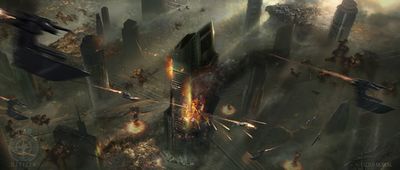Tiber System

The star traveler’s guide to Tiber could best be summed up with a single word: don’t. Or rather, DON’T! The site of countless battles between man and monster, Tiber is a bleeding wound on the face of the explored galaxy that shows absolutely no sign of healing.
Tiber was first charted by UEE long-range explorers in 2474, at which time it was promptly filed away as an uninteresting star system. A standard K type main sequence star orbited by two small planets, Tiber bore no interesting resources, strategic jump lines or anything else that would make it appealing for terraformers or other developers.
Following the UEE’s failure to hold Orion, its forces fell back to Caliban and Tiber. Given the obvious advantages of Caliban, most of these forces were stationed there rather than in Tiber. It should have come as no surprise that the Vanduul seized upon the all but undefended Tiber system as a base for raids further into Human territory. Vanduul tribes moved into the system and essentially established a permanent garrison.
Grinder
When Tiber’s role in the then-shocking Vanduul assaults was discovered, the UEE dispatched its elite Sixth Battle Group on a cleansing mission. Armed with antimatter bombs, the fleet roasted the Vanduul encampments on Tiber II with impunity, leaving the surface a temporarily glowing mess. The response was immediate, overwhelming, and the most seemingly organized action that has ever been witnessed of the Vanduul: elite Vanduul carrier air wings, the best of the best, cut into the otherwise occupied UEE force and slaughtered them to the last man.
Only a single remote observer, stationed at the jump point to Garron, escaped to deliver word of the devastation. Thus was born Grinder, ground zero of a multi-generational war between mankind and the Vanduul. In the ensuing years, no fewer than nineteen major initiatives have been made to push the Vanduul out of Tiber.
Massive fleet actions, attempts at global landings to hold Tiber II itself, and even “clean slate” operations designed to simply eliminate the ability of the system to sustain military occupation have all fallen flat. Millions have died in these attempts, and the ever-expanding fields of wreckage are now legendary. Countless civilians, seeing the deadly battlefield debris as potential for profit, have made the same leap with similar fatal results.
Today, the battle continues unabated. In addition to regular reconnaissance sorties (and occasional reconnaissance-in-force missions) the system is frequented by thousands of private spacecraft commanders each year. Whether they are attempting to prove themselves by engaging a Scythe in fighter combat or trying to profit from the system’s resources, their fate is nearly always the same: left as grist for Grinder.
The only remotely “safe” time to visit Tiber is, surprisingly, during a major battle. With UEE supply chains around the galaxy stretched to the limit, the military is frequently interested in civilian support for combat operations. Support ships carrying medical supplies and other necessities will generally be well-protected, providing they stay away from the battlelines themselves. Of course, identifying where the battlelines hang can be problematic itself.
Tiber I
Tiber I is a small, dense planet close to Tiber’s sun. The planet’s CO2 -heavy atmosphere is breathable, but the extreme heat from the nearby sun would make life here an unpleasant proposition, even without the constant combat. Although extensive surveys have not been conducted, all available research indicates that there is nothing of value on Tiber I, and it is hard to imagine anything being worth the risk and expense of putting a Human there to learn more. Tiber I’s orbit is nestled just inside an extraordinarily heavy asteroid belt, which makes exploration even more difficult.
The asteroid belt is otherwise unremarkable, with low concentrations of valuable minerals. This belt is made up of smaller asteroids moving at high velocities, and is largely lacking in sizeable planetoids that could be converted into hidden bases (a fact of which UEE intelligence, eager to have a listening post closer to Tomb, is all too aware).
UEE deep space photography stations have recorded an unusual movement of weather systems on the surface of Tiber I, which meteorologists believe would allow for periods of improved conditions once every four years.
Average clearance is roughly three days, during which the distance imaging seems to suggest the atmosphere itself becomes noticeably clearer, with CO2 concentrations settling around the planet’s nominal polar regions. With Vanduul hunter squadrons nearby, testing this hypothesis has proven a practical impossibility.

Tiber II (Tomb)
An arid, desert world coated in nearly blood-red copper dust, Tomb represents more than anything else the unquenching maw of the Vanduul war machine. Much of the planet’s surface is coated with the wreckage of spacecraft and other former war machines. The remains of countless repelled UEE attacks, private attempts at profiting from the unusual system, and destroyed Vanduul technology layer the planet.
Tomb is not a permanent graveyard, however: the wreckage which accumulates there is in turn devoured by massive Vanduul harvesters. These mechanical beasts ingest all forms of matter and convert them for use by the Vanduul war machine. The harvesters found on Tiber have an even more terrifying dual purpose: they seem to be the source for the newer harvesters that have been dropped onto Human colonies during raids. These “mother harvesters,” visually no different from harvesters observed elsewhere, are, in effect, duplicating themselves to spread terror throughout the galaxy. Everything from starship wrecks to the bones of fallen soldiers ultimately feed the very enemy they were attempting to defeat.
The world is also home to countless Vanduul war-camps, Spartan temporary base camps used by the Vanduul forces constantly on the move through the system. While Humans would not find Tomb’s environment particularly welcoming, the Vanduul seem to thrive in the climate, and they pay little mind to the landscape of destroyed spacecraft around them. (The Vanduul have never been observed to have a particular interest in capturing technology.) Attempting to visit one of these camps would be suicide for a Human being, but declassified records from attempted Marine landings have provided a great deal of knowledge about their usual layout.
While Tomb may seem an attractive target to hopeful salvage teams, be well warned that no one is known to have successfully landed on the planet to recover any of the priceless military hardware left there. Travelers are warned to avoid any such attempt. The UEE has never been able to establish a viable landing zone on Tomb, and unless you are part of an unlucky Marine detachment, you have little hope of even reaching the surface.


